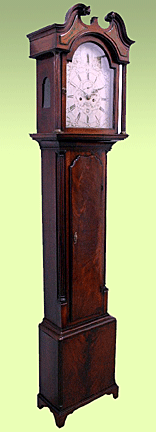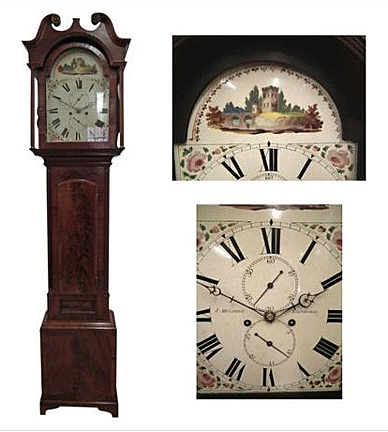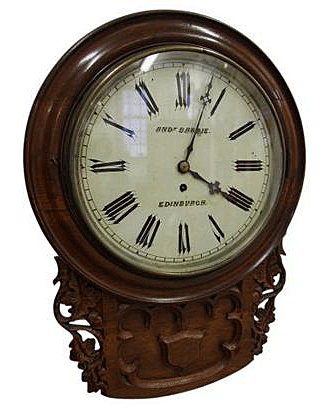A Brief History of Scottish Clockmaking
Posted by Iain Brunt
and Georgian Antiques of Edinburgh
on January 7, 2018 on Antiques.co.uk
 From
the 15th century onwards public clocks had been erected in the squares
and local spaces of larger towns around Scotland, from Peebles to
Dundee. Though the mechanisms of these early clocks were produced
overseas, it wasn’t until the late 15th century to early 16th century
that British clockmakers became competent in making and repairing
clocks. As the practice developed, an area in Edinburgh, known as Clock
Maker’s Land in the West Bow, became the center of their trade and most
notably housed the workshop and residence of the 17th-century watchmaker
and horologist Paul Roumieu. Documents of the time praised the quality
of his movements and timepieces. From
the 15th century onwards public clocks had been erected in the squares
and local spaces of larger towns around Scotland, from Peebles to
Dundee. Though the mechanisms of these early clocks were produced
overseas, it wasn’t until the late 15th century to early 16th century
that British clockmakers became competent in making and repairing
clocks. As the practice developed, an area in Edinburgh, known as Clock
Maker’s Land in the West Bow, became the center of their trade and most
notably housed the workshop and residence of the 17th-century watchmaker
and horologist Paul Roumieu. Documents of the time praised the quality
of his movements and timepieces.
Scotland has produced some prolific clock makers since then. John Gibson
was active in Edinburgh from 1758-80 and was the bound apprentice to
Daniel Binnie, a watch and clockmaker located in Nether Bow, Edinburgh
from 1747 to 1779. The Edinburgh Evening Courant mentioned Gibson’s work
on October 1, 1808: “Valuable Musical Clock For Sale… Made by John
Gibson, an eminent maker in this city, and is mounted in an elegant
mahogany case… This clock would be a great acquisition to the hall of a
mansion house.”
A brilliant example of his skill is a typical example of an Edinburgh
longcase clock, with a horn top, flame mahogany door, and mahogany case.
Dated circa 1775, the silver face has been engraved and blackened, with
“John Gibson, Edin” appearing below the hands, and features a calendar
and Roman numerals.
 Engraved
to the face are sea horses or hippocampus, with the upper body of a
horse and the lower body of fish and webbed paws. These mythical
creatures have been seen in similar designs on heraldry since the
Renaissance. Engraved
to the face are sea horses or hippocampus, with the upper body of a
horse and the lower body of fish and webbed paws. These mythical
creatures have been seen in similar designs on heraldry since the
Renaissance.
The raised pediment to the top of the clock would have been surmounted
by a sphere or gilded eagle, and at each side of the door are tapering
columns. It all stands on squat bracket feet. There are often variations
across Edinburgh longcase clocks, including the inclusion of fretwork,
or capitals to the top of the columns. Outside of London, Edinburgh
longcase clocks were desirable because of their sleek, elegant look and
thin, long door.
George IV Grandfather Clock by J. Melrose, Edinburgh – operated from the
Canongate or Nicolson Street in Edinburgh, circa 1826.
 In
the late 19th century, appreciation of clocks grew, and resulted in a
demand for the best examples of the trade. Jumping forward to recent
times, there have been efforts to emphasise the value of UK-made clocks,
especially in a market flooded with internationally made examples. For
example, a longcase clock by Alan Hamshere, completed in 1984, and
featured in the exhibition “Clock and Watchmaking Today” at the Prescot
Museum of Clock and Watchmaking in 1985. In
the late 19th century, appreciation of clocks grew, and resulted in a
demand for the best examples of the trade. Jumping forward to recent
times, there have been efforts to emphasise the value of UK-made clocks,
especially in a market flooded with internationally made examples. For
example, a longcase clock by Alan Hamshere, completed in 1984, and
featured in the exhibition “Clock and Watchmaking Today” at the Prescot
Museum of Clock and Watchmaking in 1985.
With a case veneered in birds-eye maple wood, and a weight driven
movement, the clock has a dial divided into two parts—the lower part has
a ring with 12 months of the year, the upper part is similar. The
sophisticated dial has several functions. This clock shows the
complexity of modern Scottish clocks, and how they have developed from
Georgian tastes to this timepiece.
If you'd like to see more examples of Scottish clockmaking, visit
Antiques.co.uk.
<
Back
to Guest Blog Archives
Next Guest Blog > |
